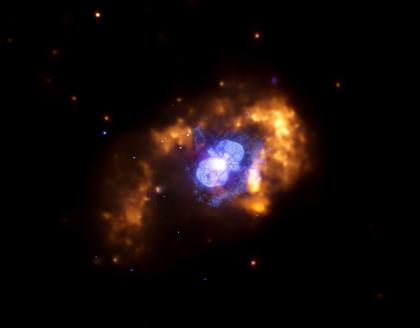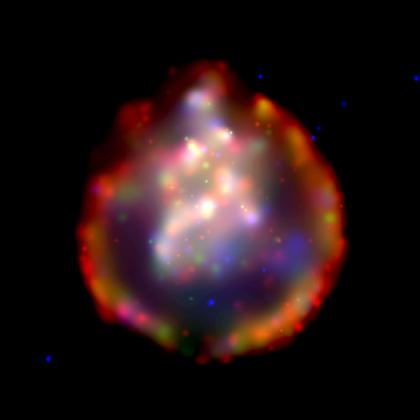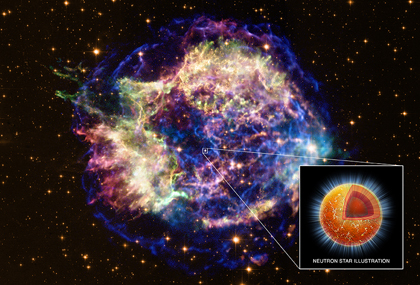Massive Stars (con't.)
The mass of the star's iron core approaches 1.4 solar masses - the Chandrasekhar Limit - due to the continued silicon and sulfur fusion in the thin shell adjacent to the iron core, and the continued fusion of iron requires more energy than is available. Once the Chandrasekhar Limit is reached, the electron degeneracy pressure of the atoms within the core is no longer able to stop the further collapse of the star; radiation pressure is no longer able to support the core against gravity and the iron core collapses. In less than a second, the core collapses from a diameter of ~8000 kilometers to ~19 kilometers. The collapse happens so fast that the outer layers have no time to react or collapse along with the core. The energy released during core collapse is unimaginable - more energy than is produced by 100 stars like the Sun during their entire lifetimes of more than 10 billion years! Most of the energy released during collapse is carried off into space by neutrinos; however a small fraction of the energy triggers the accompanying supernova explosion. The hypermassive star Eta Carinae is expected to collapse within the next 100,000 years. The supernova Remnant SNR 0103-72.6 occurred ~10,000 years ago in the Small Magellanic Cloud - a neighboring galaxy. The X-ray image shows great detail within this remnant, even though it is ~190,000 LY away. It is easier to study remnants in other galaxies, because within the Milky Way Galaxy these objects are obscured by the gas and dust within the spiral arms.
The core collapses so fast that it momentarily goes past its equilibrium point and instantaneously rebounds. The innermost layers of the star are still in-falling and meet the rebounding core, creating a super strong shock wave that runs outward through the layers towards to the star's surface. The shock wave heats the outer layers, inducing explosive nuclear fusion, and ejects the outermost layers in excess of speeds of ~16 million kilometers per hour. The energy released by the shockwave creates elements heavier than iron. When the shock wave reaches the star's surface, it heats the surface layers and brightens them – within a day or two the exploding star becomes brighter than a billion Suns. The SN1987A supernova event in the Large Magellanic Cloud galaxy was the first witnessed supernova event since Johannes Kepler recorded his in 1604. The expanding gaseous shell plows into the surrounding interstellar medium, and pushes, compresses, and intermingles with it. The material, rich in heavy elements, now seeds the interstellar space surrounding the star, and may trigger the formation of a new generation of stars. The images of the Veil Nebula and Cas A show supernovae remnants plowing through space, carrying the newly created elements into the interstellar medium. The core collapse of a massive star is a Type II supernova event. The stellar core end product left behind depends upon the initial mass of the star, and is either a neutron star, pulsar, magnetar, or black hole.
Neutron stars have passed the 1.4 solar mass Chandrasekhar limit, and are not held in equilibrium by electron degeneracy pressure. The repulsive force between electrons is not strong enough to balance gravity in a star that begins with more than ~8 solar masses and has a core remnant of more than 1.4 solar masses. The collapsing core is so massive that the electrons are forced into the atomic nuclei where they combine with protons and become neutrons. Neutron stars are held in equilibrium with neutron degeneracy pressure (strong nuclear force) which provides the pressure to stop gravity from contracting the core any further. The Type II supernova remnant Cas A contains a neutron star. Ten years of observations with Chandra have revealed a 4% decline in the temperature of this neutron star, an unexpectedly rapid cooling. Research shows that this cooling is likely caused by a neutron superfluid forming in its central regions, the first direct evidence for this bizarre state of matter in the core of a neutron star. Superfluid is a state of matter which behaves like a fluid with zero viscosity. The inset shows an artist's impression of the neutron star at the center of Cas A. The different colored layers in the cutout region show the crust (orange), the core (red), where densities are much higher, and the part of the core where the neutrons are thought to be in a superfluid state (inner red ball). The blue rays emanating from the center of the star represent the copious numbers of neutrinos -- nearly massless, weakly interacting particles -- that are created as the core temperature falls below a critical level and a neutron superfluid is formed. These neutrinos escape from the star, taking energy with them and causing the star to cool much more rapidly. Neutron degeneracy pressure maintains equilibrium with gravity for a core of no more than approximately 2.4 - 3 stellar masses.








